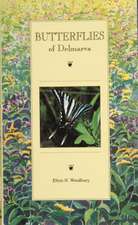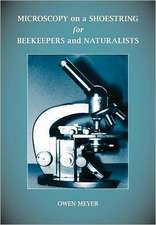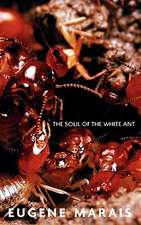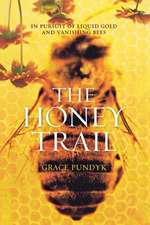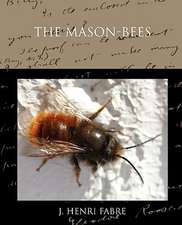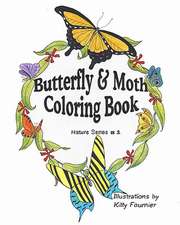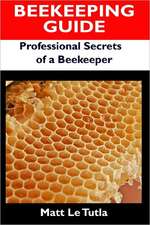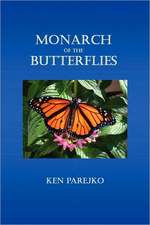Sweetness & Light: The Mysterious History of the Honeybee
Autor Hattie Ellisen Limba Engleză Paperback – 31 mar 2006
In Sweetness and Light, Hattie Ellis leads us into the hive, revealing the fascinating story of bees and honey from the Stone Age to the present, from Nepalese honey hunters to urban hives on the rooftops of New York City. Uncovering the secrets of the honeybee one by one, Ellis shows how this small insect, with a collective significance so much greater than its individual size, can carry us through past and present to tell us more about ourselves than any other living creature.
Preț: 104.36 lei
Nou
Puncte Express: 157
Preț estimativ în valută:
19.97€ • 20.85$ • 16.49£
19.97€ • 20.85$ • 16.49£
Carte tipărită la comandă
Livrare economică 15-29 aprilie
Preluare comenzi: 021 569.72.76
Specificații
ISBN-13: 9781400054060
ISBN-10: 1400054060
Pagini: 243
Ilustrații: 25 BLACK & WHITE ILLUSTRATIONS
Dimensiuni: 132 x 203 x 15 mm
Greutate: 0.18 kg
Editura: Three Rivers Press (CA)
ISBN-10: 1400054060
Pagini: 243
Ilustrații: 25 BLACK & WHITE ILLUSTRATIONS
Dimensiuni: 132 x 203 x 15 mm
Greutate: 0.18 kg
Editura: Three Rivers Press (CA)
Notă biografică
Hattie Ellis is an award-winning columnist and author who specializes in writing about food. To tell the story of bees and honey in all of its wondrous particulars, she traversed the globe from Sicilian mountainsides to Parisian parks, from Scottish moorlands to London streets, from the New Zealand bush to the California coast. She lives in East Sussex, England.
Extras
CHAPTER ONE
IN THE BEGINNING: EVOLUTION
Honey. It starts in the spring. With the brightening air comes a quickening of the world. All over the planet, plants plug into the energy of daylight. Systems are switched on; leaves feed on light; sap circulates. As spring spreads to summer, flowers in uncountable quantities open out. Within the plants lie small, secret pockets of nectaries, and within these glands swell droplets of sweet liquid. This sugary substance is a symbol of all that is desirable in nature: nectar.
The female worker honeybee hovers, lands, and bends into the center of a flower, head down for a feed. She sucks up the nectar, then she’s off to another one—accelerating so fast your eyes are left behind. She collects the nectar in a transparent, pear-shaped bag called a honey sack that lies at the front of her abdomen as part of the gut. When this sack bulges full, she flies back to her colony.
In the dark of the hive, this forager bee passes the nectar on to the house bees. The nectar will be passed from bee to bee, becoming progressively more concentrated as it goes. The bees push the nectar into flat drops on the underside of the proboscis, and exposure to air helps evaporate some of the liquid. A drop will be pumped in and out many times, each time becoming a little less liquid. Sucked and pumped, sucked and pumped, sucked and pumped, the nectar concentrates down to 40 percent of its original moisture, and then small droplets are deposited onto the floor of the wax comb where the warm air in the hive evaporates it yet further. As foraging bees bring back the sweet flow, thousands more beat their wings to create a through-draft; the colony is a mass of wings working together to fan off the moisture with warm air. When the liquid reduces right down, and each cell’s watery gleam has thickened to a sticky bead, the bees top the full cell with a wax cap. Sealed and stored, the honey is now ready until needed, rather as you might keep a pot upon a cupboard shelf.
But wait. This image of the well-ordered household with its well-stocked larder is too tame, too neat, too cozy. It is far less strange and extraordinary than the truth: the miraculous has been domesticated. For what is honey, once you take it off the shelf and trace back to where it comes from? Each place, each plant produces a different honey. Honeys have tastes, colors, and consistencies according to their nectar sources. Some honeys come largely from
a single flower—monofloral honeys—while multifloral honeys gather the nectar of many plants from places such as meadows and mountainsides. From the tough scented carpet of thyme and marjoram on the slopes of Greek islands flows a nectar that becomes a honey that was once offered to gods. The tree-of-heaven’s honey tastes faintly of muscat grapes. Bees fly between orange blossoms and the splayed white flowers of the coffee plant, fusing their flavors as they go. They fly to milkweed, thistles, and goldenrod; to dandelions and tulip trees, to acacias and rock roses. A slightly salty, snow-white honey comes from the pohutukawa, the Christmas tree of the blazing, antipodean midsummer, that flowers flame red around December. Frothy white blossoms on apple trees produce orchard honey. The violet, snaky stalks of viper’s bugloss make a clear gold honey. Italian chestnut trees spread a dark fragrance; mango honey is truly fruity, and the aguinaldo blanco of Central America yields a water-white honey said to be one of the clearest in the world. Fields of lavender, of beans, of oilseed rape; suburban gardens full of flowers nodding with bees; Californian desert and Himalayan cliff; the bone-dry Kalahari and the looping, raveling rain forest; the fairy-tale dark-depths of woods in Central Europe with their resinous honeydew; carob plantations and Sicilian lemon groves; rambling British blackberries and the many different kinds of eucalyptus in Australia, which flow unpredictably, perhaps every two, eight, or twelve years; the rich, dark resonating brown of rosemary honey; the slightly minty honey from the linden trees on the Lower East Side of New York City: all these plants, all these places, stream with nectar in large gouts or pinprick stars; all come through bees to make honey.
It is closer to the truth to say that bees perform an act of alchemy. Honey is nothing less than concentrated nectar; and a pot of good honey is the essence of its surroundings, a sweet, fragrant river from a million tributaries, carried across the air and flowing gold into the pot through the transforming power of the bee.
THE HONEYBEE’S STORY must be traced back through an incomparably vast stretch of time, through clues strewn in the great evolutionary flow. The search feels like a detective story. Where to begin? The canvas is unimaginably large. Life—the chemical change that sparked inanimate matter to reproducing molecules—probably began about four billion years ago. (Humans, of the sort we would recognize, have probably existed for about 1.5 to 2 million years, to give some idea of how insignificant we are in terms of time.) The next stirrings of existence began in the water that surrounded both plants and animals, bringing them food and oxygen and supporting their bodies. Life moved from seawater to freshwater, creeping further toward land and then colonizing its swampy margins. A coating of primitive plants moved across the earth. It was insects that evolved to feed on these plants, and their remains have been found in fossilized swamps and remnants of the earliest forests.
Early insects were wingless; then, as the plants grew, they developed wings that could more easily reach the new heights. Bees, like ants and wasps, are part of the Hymenoptera, or “membrane wing,” order, with two sets of filmy wings hooked together to cause less turbulence and drag in flight. The wings are stretched over a sparse network of veins that provide their support structure, like the frame for a kite’s flexible fabric.
Evolution is the blind shuffle of DNA, filtered by success of reproduction. Insects have succeeded by being the ultimate niche operators of the animal kingdom, able to work in any environment, from Arctic wastes to mountaintops to suburban gardens to deserts. One reason they can do this is that their exoskeletons can adapt relatively easily, the animal’s outside altering without the insect’s inside having to change. The exoskeleton adapted into different kinds of wings; it turned into the needling legs of the spinning spider and the musical saws of the jumping grasshopper; it became the warning spots of the ladybug and the aggressive stripes of the wasp and the bee; it became the battling claws of the stag beetle and the stabbing jab of the mosquito. The insect has an external kit that tools it up for many different circumstances and its evolutionary success is proved by the numbers. There are a million insects for each human on the planet, and they make up around half of all named species.
How did some insects become bees? The first clue is their intimate connection with flowering plants, or angiosperms, which arrived on earth during the geological era known as the Cretaceous, between 140 and 60 million years ago. Primitive plants spread their seed by wind, casting their pollen into the world in profligate quantities. Then some plants began to make smaller quantities of pollen than their predecessors and invested more energy, instead, in enticing creatures such as insects to visit. It was a smart move. Insects evolved to feed on the protein-rich pollen, the tiny grains that are the sex-dust of male reproduction. When pollen attaches to an insect’s body, it can be transferred to other plants and—bingo!—pollination occurs. When you want to attract lovers, it pays to dress up. Flashy, colorful, sweet-smelling flowers evolved, appealing to animals, and particularly insects. Nectar, the base material of honey, is part of the flower’s tactics of attraction, along with petals, pollen, scent, shape, and color. Honey, then, is an elixir of sex.
THAT FLOWERS EVOLVED at the same time as many of the insects must be no coincidence. Bees and blooms are so twisted together by the twin necessities of existence, of reproduction and food, that their development must have been interdependent. The chronology of this is not entirely certain, however. The clues of paleontology can literally be writ in stone, yet they are still random clues to life, and petals and insects preserve far less well than dinosaur bones.
The oldest known bee fossil was found in New Jersey. This single female insect is entombed in the hard, orange glow of amber. She was, poor scrap, trapped by sticky coniferous tree resin. She was also captured for posterity. The resin turned to a light, transparent fossil and the bee was held forever, legs stretched out, almost flailing, as though she is either tumbling through some otherworldly medium, or about to land on a plant that produced the pollen of eighty million years ago. The bee is caught in a fossilized freeze-frame, the durability of the rock starkly framing the delicacy of the fragment of life within. She dates from the late Cretaceous and was already well evolved, evidence pointing toward the fact that bees had been around at least as long as flowers.
Then, in 1994, a discovery was made that could push back the date of the evolution of bees even further. It raised the idea that they could have been on the planet perhaps even longer than flowers.
The Petrified Forest National Park in eastern Arizona is a time capsule of stone logs gradually being uncovered by erosion and explorations. The 100,000 acres once contained the Black Forest of ancient conifers that thrived in the semitropical world of the Triassic period, more than 200 million years ago. Then volcanic eruptions sent a huge flood that flattened the trees like skittles and buried them deep underground, devoid of oxygen. Over time, the wood started to mineralize. In some cases, iron oxides in the wood turned the trees into a startling range of colors such as ruby brown and lichen orange; in other cases, they stayed as black as the forest’s name.
Time passed. The landmass of planet earth that had been a supercontinent split into a northern half, Laurasia, which later became North America and Eurasia, and a southern half, which became South America, Africa, Australia, peninsular India, and Antarctica. Humans arrived. Humans evolved. Humans became curious. Humans became acquisitive.
By the nineteenth century, the fossilized forest had gained a certain celebrity. On the orders of the Civil War commander General Sherman two petrified tree trunks were carted off to the Smithsonian’s National Museum of Natural History, where they remain today. Amateurs and professionals also came to the forest, picking up souvenirs and booty, from shards to logs. The petrified fragments were turned into clock bases, jewelry, and luxurious trinkets sold at Tiffany. In 1962, President John F. Kennedy made the Petrified Forest a national park, affording it some protection.
At the end of the twentieth century, teams studying ancient ecosystems and climates tracked through the park, trying to gather clues about the forest’s original existence. Among the most interesting finds, of a group led by Dr. Tim Demko, were approximately one hundred insects’ nests. The inch-long flask-shaped cells were clustered together, and the entrance was probably through open knot holes in the wood. The formation of the cells and details of their constructions led the scientists to believe they were built by ancient ancestors of today’s bees. Elsewhere on the site, they also later found nests closely resembling those of the modern sweat bees (Halictidae), so called for their attraction to perspiration. Chemical analysis of the Petrified Forest nests showed that the cells contained some of the organic compounds found in beeswax.
The early date of the forest could be significant. If these were, indeed, bees’ nests—and the evidence certainly pointed to this, though some say you would need to find bee bodies to be certain—it would mean bees existed 207 to 220 million years ago, at least 120 million years or so before the oldest previously known bee fossil. Beyond this, the nests are older than the earliest known flower fossils. Could it be that bees existed, in some form, for ages before flowers?
It depends, partly, on how you define a bee. Evolution is, after all, a continuum, and these could be bee ancestors rather than bees themselves. It also depends upon when flowers first evolved, and fragile plants leave an elusive fossil trail. Charles Darwin called the origin of flowering plants “an abominable mystery,” and it remains, for all the theories, ultimately mysterious.
What seems more certain is that bees probably evolved from a descendant of today’s carnivorous hunting wasp. The Russian entomologist Professor S. I. Malyshev posited a theory about how this happened, and this leads to part of what makes a bee a bee: its diet. Bees are unusual among insects because the developing young have the same diet as the adult; both survive exclusively on plants. The hunting wasps still feed their grubs on protein-rich aphids that they kill with their jaws. They also eat, as bees do, the honeydew exuded from plant-sucking aphids. Malyshev argued that these early carnivorous wasps, in the process of killing their prey to feed their young, would taste the sweetness in the aphid’s body that they also found in honeydew. It would have been a short evolutionary step for the insects to feed entirely on plants, in their larval as well as their adult diet.
We do not know for certain if and how the bee first evolved from a carnivorous hunting wasp. We do not know the earliest date of the bee or the bloom. What we have are theories looped onto fragments. It makes the evolutionary detective story no less intriguing.
To get back to a concrete fact—one you can eat—Malyshev’s speculations connect to another pot in my kitchen cupboard. Honeydew honey is a delectable curiosity. Strong, to the point of almost being savory, it is not made from the nectar of flowers at all. Rather, bees collect honeydew from the aphids in forests, just as the hunting wasp did all that time ago. This honey is therefore a sticky substance made from fluid ingested by two kinds of insect. But, as I spread the darkly delicious ooze on my toast, I prefer to think of honeydew as a possible clue to the evolution of the honeybee.
From the Hardcover edition.
IN THE BEGINNING: EVOLUTION
Honey. It starts in the spring. With the brightening air comes a quickening of the world. All over the planet, plants plug into the energy of daylight. Systems are switched on; leaves feed on light; sap circulates. As spring spreads to summer, flowers in uncountable quantities open out. Within the plants lie small, secret pockets of nectaries, and within these glands swell droplets of sweet liquid. This sugary substance is a symbol of all that is desirable in nature: nectar.
The female worker honeybee hovers, lands, and bends into the center of a flower, head down for a feed. She sucks up the nectar, then she’s off to another one—accelerating so fast your eyes are left behind. She collects the nectar in a transparent, pear-shaped bag called a honey sack that lies at the front of her abdomen as part of the gut. When this sack bulges full, she flies back to her colony.
In the dark of the hive, this forager bee passes the nectar on to the house bees. The nectar will be passed from bee to bee, becoming progressively more concentrated as it goes. The bees push the nectar into flat drops on the underside of the proboscis, and exposure to air helps evaporate some of the liquid. A drop will be pumped in and out many times, each time becoming a little less liquid. Sucked and pumped, sucked and pumped, sucked and pumped, the nectar concentrates down to 40 percent of its original moisture, and then small droplets are deposited onto the floor of the wax comb where the warm air in the hive evaporates it yet further. As foraging bees bring back the sweet flow, thousands more beat their wings to create a through-draft; the colony is a mass of wings working together to fan off the moisture with warm air. When the liquid reduces right down, and each cell’s watery gleam has thickened to a sticky bead, the bees top the full cell with a wax cap. Sealed and stored, the honey is now ready until needed, rather as you might keep a pot upon a cupboard shelf.
But wait. This image of the well-ordered household with its well-stocked larder is too tame, too neat, too cozy. It is far less strange and extraordinary than the truth: the miraculous has been domesticated. For what is honey, once you take it off the shelf and trace back to where it comes from? Each place, each plant produces a different honey. Honeys have tastes, colors, and consistencies according to their nectar sources. Some honeys come largely from
a single flower—monofloral honeys—while multifloral honeys gather the nectar of many plants from places such as meadows and mountainsides. From the tough scented carpet of thyme and marjoram on the slopes of Greek islands flows a nectar that becomes a honey that was once offered to gods. The tree-of-heaven’s honey tastes faintly of muscat grapes. Bees fly between orange blossoms and the splayed white flowers of the coffee plant, fusing their flavors as they go. They fly to milkweed, thistles, and goldenrod; to dandelions and tulip trees, to acacias and rock roses. A slightly salty, snow-white honey comes from the pohutukawa, the Christmas tree of the blazing, antipodean midsummer, that flowers flame red around December. Frothy white blossoms on apple trees produce orchard honey. The violet, snaky stalks of viper’s bugloss make a clear gold honey. Italian chestnut trees spread a dark fragrance; mango honey is truly fruity, and the aguinaldo blanco of Central America yields a water-white honey said to be one of the clearest in the world. Fields of lavender, of beans, of oilseed rape; suburban gardens full of flowers nodding with bees; Californian desert and Himalayan cliff; the bone-dry Kalahari and the looping, raveling rain forest; the fairy-tale dark-depths of woods in Central Europe with their resinous honeydew; carob plantations and Sicilian lemon groves; rambling British blackberries and the many different kinds of eucalyptus in Australia, which flow unpredictably, perhaps every two, eight, or twelve years; the rich, dark resonating brown of rosemary honey; the slightly minty honey from the linden trees on the Lower East Side of New York City: all these plants, all these places, stream with nectar in large gouts or pinprick stars; all come through bees to make honey.
It is closer to the truth to say that bees perform an act of alchemy. Honey is nothing less than concentrated nectar; and a pot of good honey is the essence of its surroundings, a sweet, fragrant river from a million tributaries, carried across the air and flowing gold into the pot through the transforming power of the bee.
THE HONEYBEE’S STORY must be traced back through an incomparably vast stretch of time, through clues strewn in the great evolutionary flow. The search feels like a detective story. Where to begin? The canvas is unimaginably large. Life—the chemical change that sparked inanimate matter to reproducing molecules—probably began about four billion years ago. (Humans, of the sort we would recognize, have probably existed for about 1.5 to 2 million years, to give some idea of how insignificant we are in terms of time.) The next stirrings of existence began in the water that surrounded both plants and animals, bringing them food and oxygen and supporting their bodies. Life moved from seawater to freshwater, creeping further toward land and then colonizing its swampy margins. A coating of primitive plants moved across the earth. It was insects that evolved to feed on these plants, and their remains have been found in fossilized swamps and remnants of the earliest forests.
Early insects were wingless; then, as the plants grew, they developed wings that could more easily reach the new heights. Bees, like ants and wasps, are part of the Hymenoptera, or “membrane wing,” order, with two sets of filmy wings hooked together to cause less turbulence and drag in flight. The wings are stretched over a sparse network of veins that provide their support structure, like the frame for a kite’s flexible fabric.
Evolution is the blind shuffle of DNA, filtered by success of reproduction. Insects have succeeded by being the ultimate niche operators of the animal kingdom, able to work in any environment, from Arctic wastes to mountaintops to suburban gardens to deserts. One reason they can do this is that their exoskeletons can adapt relatively easily, the animal’s outside altering without the insect’s inside having to change. The exoskeleton adapted into different kinds of wings; it turned into the needling legs of the spinning spider and the musical saws of the jumping grasshopper; it became the warning spots of the ladybug and the aggressive stripes of the wasp and the bee; it became the battling claws of the stag beetle and the stabbing jab of the mosquito. The insect has an external kit that tools it up for many different circumstances and its evolutionary success is proved by the numbers. There are a million insects for each human on the planet, and they make up around half of all named species.
How did some insects become bees? The first clue is their intimate connection with flowering plants, or angiosperms, which arrived on earth during the geological era known as the Cretaceous, between 140 and 60 million years ago. Primitive plants spread their seed by wind, casting their pollen into the world in profligate quantities. Then some plants began to make smaller quantities of pollen than their predecessors and invested more energy, instead, in enticing creatures such as insects to visit. It was a smart move. Insects evolved to feed on the protein-rich pollen, the tiny grains that are the sex-dust of male reproduction. When pollen attaches to an insect’s body, it can be transferred to other plants and—bingo!—pollination occurs. When you want to attract lovers, it pays to dress up. Flashy, colorful, sweet-smelling flowers evolved, appealing to animals, and particularly insects. Nectar, the base material of honey, is part of the flower’s tactics of attraction, along with petals, pollen, scent, shape, and color. Honey, then, is an elixir of sex.
THAT FLOWERS EVOLVED at the same time as many of the insects must be no coincidence. Bees and blooms are so twisted together by the twin necessities of existence, of reproduction and food, that their development must have been interdependent. The chronology of this is not entirely certain, however. The clues of paleontology can literally be writ in stone, yet they are still random clues to life, and petals and insects preserve far less well than dinosaur bones.
The oldest known bee fossil was found in New Jersey. This single female insect is entombed in the hard, orange glow of amber. She was, poor scrap, trapped by sticky coniferous tree resin. She was also captured for posterity. The resin turned to a light, transparent fossil and the bee was held forever, legs stretched out, almost flailing, as though she is either tumbling through some otherworldly medium, or about to land on a plant that produced the pollen of eighty million years ago. The bee is caught in a fossilized freeze-frame, the durability of the rock starkly framing the delicacy of the fragment of life within. She dates from the late Cretaceous and was already well evolved, evidence pointing toward the fact that bees had been around at least as long as flowers.
Then, in 1994, a discovery was made that could push back the date of the evolution of bees even further. It raised the idea that they could have been on the planet perhaps even longer than flowers.
The Petrified Forest National Park in eastern Arizona is a time capsule of stone logs gradually being uncovered by erosion and explorations. The 100,000 acres once contained the Black Forest of ancient conifers that thrived in the semitropical world of the Triassic period, more than 200 million years ago. Then volcanic eruptions sent a huge flood that flattened the trees like skittles and buried them deep underground, devoid of oxygen. Over time, the wood started to mineralize. In some cases, iron oxides in the wood turned the trees into a startling range of colors such as ruby brown and lichen orange; in other cases, they stayed as black as the forest’s name.
Time passed. The landmass of planet earth that had been a supercontinent split into a northern half, Laurasia, which later became North America and Eurasia, and a southern half, which became South America, Africa, Australia, peninsular India, and Antarctica. Humans arrived. Humans evolved. Humans became curious. Humans became acquisitive.
By the nineteenth century, the fossilized forest had gained a certain celebrity. On the orders of the Civil War commander General Sherman two petrified tree trunks were carted off to the Smithsonian’s National Museum of Natural History, where they remain today. Amateurs and professionals also came to the forest, picking up souvenirs and booty, from shards to logs. The petrified fragments were turned into clock bases, jewelry, and luxurious trinkets sold at Tiffany. In 1962, President John F. Kennedy made the Petrified Forest a national park, affording it some protection.
At the end of the twentieth century, teams studying ancient ecosystems and climates tracked through the park, trying to gather clues about the forest’s original existence. Among the most interesting finds, of a group led by Dr. Tim Demko, were approximately one hundred insects’ nests. The inch-long flask-shaped cells were clustered together, and the entrance was probably through open knot holes in the wood. The formation of the cells and details of their constructions led the scientists to believe they were built by ancient ancestors of today’s bees. Elsewhere on the site, they also later found nests closely resembling those of the modern sweat bees (Halictidae), so called for their attraction to perspiration. Chemical analysis of the Petrified Forest nests showed that the cells contained some of the organic compounds found in beeswax.
The early date of the forest could be significant. If these were, indeed, bees’ nests—and the evidence certainly pointed to this, though some say you would need to find bee bodies to be certain—it would mean bees existed 207 to 220 million years ago, at least 120 million years or so before the oldest previously known bee fossil. Beyond this, the nests are older than the earliest known flower fossils. Could it be that bees existed, in some form, for ages before flowers?
It depends, partly, on how you define a bee. Evolution is, after all, a continuum, and these could be bee ancestors rather than bees themselves. It also depends upon when flowers first evolved, and fragile plants leave an elusive fossil trail. Charles Darwin called the origin of flowering plants “an abominable mystery,” and it remains, for all the theories, ultimately mysterious.
What seems more certain is that bees probably evolved from a descendant of today’s carnivorous hunting wasp. The Russian entomologist Professor S. I. Malyshev posited a theory about how this happened, and this leads to part of what makes a bee a bee: its diet. Bees are unusual among insects because the developing young have the same diet as the adult; both survive exclusively on plants. The hunting wasps still feed their grubs on protein-rich aphids that they kill with their jaws. They also eat, as bees do, the honeydew exuded from plant-sucking aphids. Malyshev argued that these early carnivorous wasps, in the process of killing their prey to feed their young, would taste the sweetness in the aphid’s body that they also found in honeydew. It would have been a short evolutionary step for the insects to feed entirely on plants, in their larval as well as their adult diet.
We do not know for certain if and how the bee first evolved from a carnivorous hunting wasp. We do not know the earliest date of the bee or the bloom. What we have are theories looped onto fragments. It makes the evolutionary detective story no less intriguing.
To get back to a concrete fact—one you can eat—Malyshev’s speculations connect to another pot in my kitchen cupboard. Honeydew honey is a delectable curiosity. Strong, to the point of almost being savory, it is not made from the nectar of flowers at all. Rather, bees collect honeydew from the aphids in forests, just as the hunting wasp did all that time ago. This honey is therefore a sticky substance made from fluid ingested by two kinds of insect. But, as I spread the darkly delicious ooze on my toast, I prefer to think of honeydew as a possible clue to the evolution of the honeybee.
From the Hardcover edition.
Recenzii
“Deftly blending natural history, human history, literature, biography, and biology, Ellis provides a graceful survey as entertaining as it is enlightening.” —Los Angeles Times
Descriere
In a delightful tapestry of popular science and social history, Ellis explores the fascinating ways of the honeybee, one of the natural world's true wonders. 20 photos.

